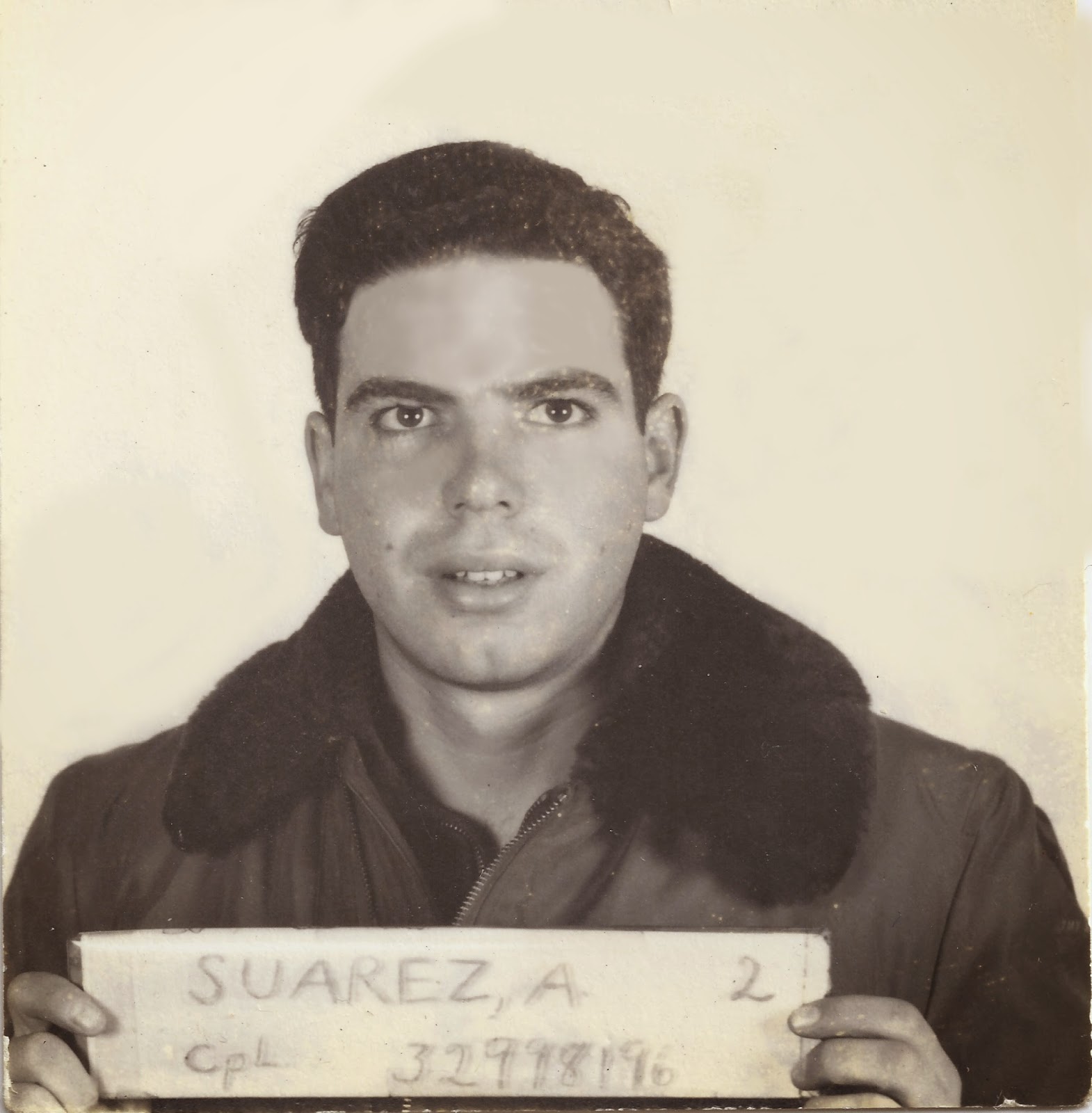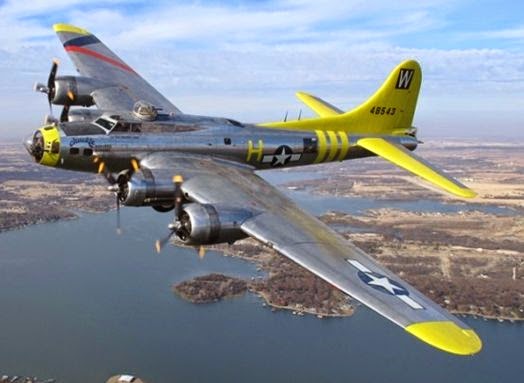70 years ago my uncle, Staff Sergeant Tony Suarez, started flying combat missions as a gunner in B17 Flying Fortresses from Station 174 in Sudbury, England as part of the 8th Air Force, 486th Bombing Group, 832nd Squadron. I intend to honor his memory by writing about each one of his missions on their 70th anniversary.
 |
| SSGT Tony Suarez with Air Gunner's wings. |
Let's start this tale by stating that being a crewman in the 8th Air Force was perhaps the most dangerous duty in any of the American Armed Forces in WWII. Around 135,000 men flew with the 8th Air Force. At the end of the war, over 30,000 lay dead or had gone missing and another 28,000 survived being shot down to be held prisoner in German POW camps.
Service in the air was dangerous but at the same time amazingly glamorous to the outsider. The 8th Air Force was home to actors Jimmy Stewart and Clark Gable. Clark Gable, one of the top celebrities at the time, volunteered to be a gunner and earned his Gunner's Wings in early 1943. Adolf Hitler personally put a bounty on his capture and the news spread! The allure of becoming a gunner in the fight against Nazi Germany must have been irresistible! In August of 1943, Antonio Suarez enlisted!
Clark Gable at Aerial Gunnery School
We don't know a lot about Tony's training, but these are some of his photographs during that time:
 |
| Corporal Suarez |
 |
| Tony, first from left |
To give you an idea of what a bombing mission in a B17 was like, here is a clip from the documentary "Target for Today" with footage from 1943. Notice the intense air combat! This being a propaganda film, you get the impression that the B17's were swatting German fighters off the sky...but it wasn't quite like that, the cost to the bomber force was severe! Do notice the air bursts of Anti-Aircraft Artillery or flak, which were also deadly.
Mercifully, by 1945, when Tony arrived in England, the tide of the war had turned in favor of the 8th Air Force. The Luftwaffe's (German Air Force) dominance over the skies of Europe had been broken (thanks to the introduction of the P51 Mustang), but not entirely eliminated. However, the strength of the anti-aircraft increased. All the targets worth bombing had been heavily protected. And the danger all too real. Here's a photo of B17's flying through heavy flak.
Tony was assigned to the 486th Bombing Group, 832nd Squadron, which was based in Station 174 in Sudbury.
Harley R. Stroven, was an armaments officer in Tony's Bomb Group, documented his time in Station 174 with his 8mm camera and produced a very interesting documentary of his own experiences. You will see Station 174, where Tony served, the town of Sudbury in those days, and many insights into the life of the 486th! There is footage of the aircraft returning from missions with damage and landing in trouble. He also has footage from a bombing mission. Most striking to me was when he mentions, "in this mission we lost two aircraft that collided after bombs away". He shows footage of the aircraft right behind their left wing. This is from the mission log from the 486th "A/C #875 collides with #949 (pilots Eakin and Crawford) in a turn off target. 18 crewman MIA."
This is Tony's crew, identified by its pilot, 1st Lieutenant William Moran. This picture was found among Tony's possessions, and we presume it was taken in front of their barracks in Station 174. He is in the front row, second from the left.
Tony's Crew Position:
Notice above that Tony is listed as Nose/Togglier. By 1945, the operations and tactics of bombing had evolved from the early days. Navigation had now been aided by the use of radar. Pathfinder aircraft would be assigned to the Bomber Groups and they would lead the formations out to the targets. The best navigators would be selected to fly on those planes. Similarly, the best bombardiers would be selected to decide when the bombs would be released instead of relying on the bombardier of each aircraft to identify the target and release the bombs. So Tony's crew didn't have a bombardier, they assigned the Nose gunner to fly on the bombardier seat and man the front machine guns AND toggle the bomb switch when the lead bombardier released the bombs. Therefore the name togglier.
 |
| Office shared by Navigator and Bombardier/Togglier in the B17 |
This aircraft below is one of only 12 or so B17's in flying condition. It has the markings of a Pathfinder aircraft of Tony's very own squadron.
Tony's son, Jose and I in front of the "Nine O Nine", the Collings Foundation B17 bomber in Worcester, MA in September of 2014. We hoped to catch a ride in it that day, but the weather didn't cooperate. We hope to accomplish this mission soon!









Xuancy, what a wonderful thing you are doing paying tribute to Tony and his military missions. What a lovely gift to his kids! :) Cuchita
ReplyDeleteAwesome site! It helps me to understand the world of my grandmother's cousin MSgt John F. Crahan from Wheeling, West Virginia who was Killed In Action on 27 December 1944 when his B17G, The Gloria Ann II, crashed on takeoff from Franlingham, England. Their intended target was the railway marshalling yard in Fulda, Germany.
ReplyDeleteMSgt Crahan was also a Nose/Togglier like your uncle.
Vern, I'm glad this was useful to you! The sacrifices made by those brave young men were incredible! May the memory of their struggles and accomplishments live forever!
DeleteRegards, Juan
Juan - my dad is next to your uncle in the crew photo. I can’t believe I’ve come across this information! Clarence Bruntz was the RO in the 832nd. He passed in 1993. I always wished I’d had more time with him and that he would’ve been willing to talk about the war and his experiences. I’m so looking forward to reading through all of Tony’s missions. Now I’ll know what my dad went through. Thank you for posting this.
ReplyDelete